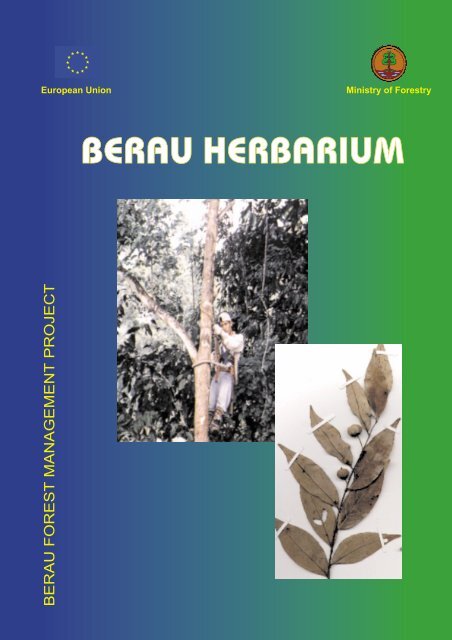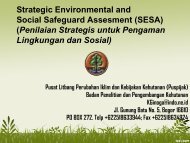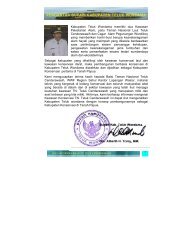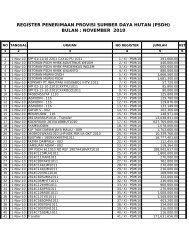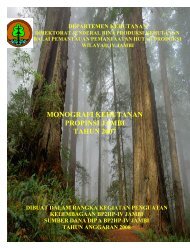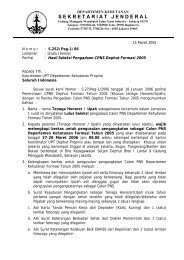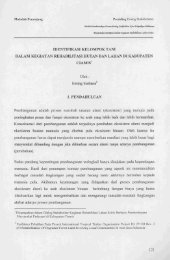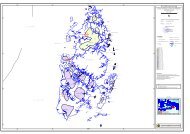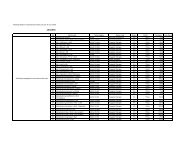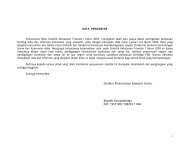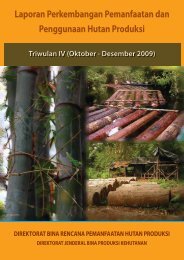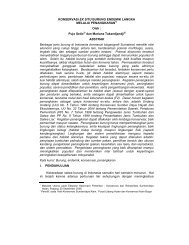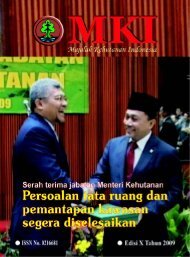BERAU HERBARIUM
BERAU HERBARIUM
BERAU HERBARIUM
Create successful ePaper yourself
Turn your PDF publications into a flip-book with our unique Google optimized e-Paper software.
European Union<br />
Ministry of Forestry<br />
<strong>BERAU</strong> <strong>HERBARIUM</strong>
<strong>BERAU</strong> <strong>HERBARIUM</strong><br />
Dr. Paul J.A. Keβler<br />
Dr. Gerald Rathert<br />
Berau Forest Management Project<br />
PT Inhutani I<br />
Jakarta 2001
Berau Forest Management Project (BFMP)<br />
Manggala Wanabakti Building Block IV 7 th Floor, Room 707 – 709 A<br />
Jl. Jend. Gatot Subroto, Jakarta 10270, Indonesia<br />
Telepon : (62) (021) 572 0204, 570 4508, 570 3246/65 Ministry Ext. 5399<br />
Tel. / Fax : (62) (021) 572 0205<br />
E-mail : bfmp@cbn.net.id<br />
Http : //www.bfmp.or.id<br />
All rights reserved. This book is protected by copyright.<br />
No part of the text may be reproduced, stored in a retrieval system,<br />
or transmitted, in any form or by any means, electronic, mechanical,<br />
photocopying, recording, or otherwise without written permission from the<br />
copyright holder.<br />
Copyright: Berau Forest Management Project<br />
First published 2001<br />
ISBN number:<br />
Perpustakaan Nasional: katalog dalam terbitan (KDT)<br />
(National Library: catalog in publication)<br />
European Union<br />
Ministry of Forestry<br />
PT Inhutani I<br />
i
PREFACE<br />
There are probably 10,000 – 20,000 plant species in Kalimantan. The flora is rich in<br />
diversity and economically essential, yet has not been fully explored. New species are<br />
continually being found. New initiatives are needed to promote more exploration, and to<br />
use this information for practical needs like sustainable forest management and protection<br />
of Indonesia’s rich biodiversity heritage.<br />
Collecting plant data requires collection and cataloguing of plant specimens in a herbarium<br />
– a botanical “library”. Indonesia’s national herbarium is in Bogor. East Kalimantan has a<br />
regional tree herbarium in Wanariset, Samboja.<br />
The Berau Forest Management Project (BFMP) identified a need to develop herbarium<br />
facilities for Berau to better understand its working environment, and to enhance available<br />
resources for research and education. Berau’s forest is assumed to be biologically rich, yet<br />
because there has been so little botanical collection in this part of East Kalimantan there is a<br />
lack of information and references about what trees really are present. Direct benefits<br />
include a better understanding of forest that will foster ever more appropriate sustainable<br />
forest management techniques.<br />
The Berau herbarium has now reached an international standard and offers an excellent<br />
opportunity to national and international scientists, students and laymen to learn more about<br />
the plant diversity of East Kalimantan. An advantage of the Berau location is that dry<br />
herbarium material can be studied with full access to the tropical lowland forest within less<br />
than two hours drive. It is also part of a commercial concession with practical forest<br />
operators managing the resource. This makes it an ideal base for many activities like tree<br />
recognition courses to support sustainable forest management, marketing studies, and also<br />
for ecological and taxonomic studies.<br />
Jakarta, October 2001<br />
Graham Tyrie<br />
Team Leader and<br />
Co-Director BFMP<br />
Muhandis Natadiwirya<br />
Co-Director BFMP and<br />
President Director PT Inhutani I<br />
ii
CONTENTS<br />
PREFACE.........................................................................................................................ii<br />
CONTENTS...................................................................................................................... 1<br />
ABBREVIATIONS.......................................................................................................... V<br />
INTRODUCTION ............................................................................................................ 1<br />
BACKGROUND............................................................................................................... 1<br />
PURPOSE .........................................................................................................................2<br />
<strong>BERAU</strong> TREE DIVERSITY............................................................................................ 3<br />
LOCATION AND FACILITIES...................................................................................... 5<br />
ORGANISATION AND MANAGEMENT ..................................................................... 6<br />
PLANT MATERIAL COLLECTION AND PREPARATION ...................................... 6<br />
SOME DEFINITIONS........................................................................................................... 6<br />
PRESERVATION OF SPECIMENS.......................................................................................... 9<br />
FUNCTION AND ORGANIZATION OF A <strong>HERBARIUM</strong> ........................................ 11<br />
ESSENTIAL REQUIREMENTS FOR A <strong>HERBARIUM</strong> BUILDING ................................................ 11<br />
DRYING SPECIMENS ....................................................................................................... 11<br />
PROCESSING UNMOUNTED SPECIMENS ............................................................................ 12<br />
MOUNTING SPECIMENS .................................................................................................. 13<br />
IDENTIFICATION OF SPECIMENS ...................................................................................... 13<br />
ARRANGEMENT ............................................................................................................. 14<br />
STRAPPING METHOD ...................................................................................................... 14<br />
DATA PROCESSING .................................................................................................... 17<br />
RAPID DATA ENTRY (RDE) ........................................................................................... 17<br />
DATA EXTRACTION ........................................................................................................ 17<br />
OUTPUT......................................................................................................................... 17<br />
EXPORTING DATA TO OTHER FORMATS ........................................................................... 18<br />
ACHIEVEMENTS OF THE <strong>BERAU</strong> <strong>HERBARIUM</strong> .................................................. 19<br />
iii
TRAINING ..................................................................................................................... 19<br />
FUTURE <strong>HERBARIUM</strong> USE AND EXPANSION....................................................... 20<br />
LITERATURE................................................................................................................ 20<br />
SPECIES IN <strong>BERAU</strong> <strong>HERBARIUM</strong> ............................................................................ 23<br />
iv
ABBREVIATIONS<br />
A/GH<br />
BFMP<br />
<strong>BERAU</strong><br />
BLK<br />
BO<br />
CIRAD-Forêt<br />
Dbh<br />
E<br />
FORDA<br />
K<br />
L<br />
PSP<br />
RKL<br />
STREK<br />
TPTI<br />
WAN<br />
Arnold Arboretum and Gray Herbarium, Harvard University,<br />
Cambridge, MA, USA<br />
Berau Forest Management Project<br />
Berau Herbarium, branch of WAN<br />
Institute for Forestry Training / Balai Latihan Kehutanan<br />
Herbarium Bogoriense, Bogor, Indonesia<br />
Centre de Cooperation Internationale en Recherche Agronomique<br />
pour le Developpment<br />
diameter at breast height<br />
Royal Botanical Gardens Edinburgh/UK<br />
Forest Research and Development Agency / Badan Penelitian dan<br />
Pengembangan Kehutanan<br />
Royal Botanic Gardens Kew, Kew/UK<br />
National Herbarium of The Netherlands, Leiden branch, Leiden, The<br />
Netherlands<br />
Permanent sample plots<br />
5 years concession operational plan / Rencana Karya Lima Tahun<br />
Development of silvicultural techniques for the regeneration of logged<br />
over rain forest in East Kalimantan<br />
Indonesian Selective Cutting and Planting System / Tebang Pilih dan<br />
Tanam Indonesia<br />
Herbarium Wanariset Samboja/Indonesia<br />
v
INTRODUCTION<br />
Borneo covers about 740000 km 2 and is divided between three countries. To the north lie<br />
Brunei and the Malaysian states of Sabah and Sarawak. To the south lies the largest part of<br />
the island, Kalimantan.<br />
Borneo is one of the most important centres of plant diversity in the world. There are at<br />
least 10000 - 12000 species of flowering plants and somewhere between 40 - 50% are<br />
endemic to the island. Scientific studies of Kalimantan’s flora can be dated back to 1822 in<br />
West Kalimantan, Kutai and the Mahakam River. However, more intensive botanical<br />
studies were conducted in the northern parts of Borneo, supported by the British<br />
administration and private companies. British, Dutch and German scientists dominated the<br />
early 20th century collectors. After 1914, the Northern Borneo Forestry Department started<br />
to set standards for forest management that included systematic botanical investigations.<br />
The fruits of these studies include today’s modern botanical collections in Bogor,<br />
Singapore, Kuching, Sandakan, and more recently in Wanariset, Samboja in East<br />
Kalimantan.<br />
Kalimantan’s flora still needs to be better explored. Of Borneo’s endemic species, about<br />
80% are known from the Malaysian states of Sabah and Sarawak. With more study over on<br />
the Indonesian side of the border, there is little doubt than many more will be discovered.<br />
In a long-term collaboration with various research organisations the Forest Research<br />
Institute Malaysia (FRIM) developed the Tree Flora of Sarawak and Sabah. This is the<br />
most recent coverage of tree species and their taxonomic status occurring in the Malaysian<br />
part of Borneo. There is nothing similar for Kalimantan. Yet national and international<br />
recognition of the economic and conservation value of it forests calls for this gap to be<br />
filled. There is a need for a concise Identification Flora of Borneo. It would underpin efforts<br />
to more accurately attempt to conserve and plan sustainable forest management and use of<br />
this species-rich landscape. This is an immediate and crucial need for more botanical<br />
exploration and collection in Kalimantan, the institutional, scientific and financial resources<br />
to support it.<br />
BACKGROUND<br />
Botanical surveys in Berau started with the STREK Project at the Labanan concession of PT<br />
Inhutani 1, in 1989. The overall goal was to develop silvicultural techniques for<br />
regenerating logged over rain forest as a joint venture between PT Inhutani I, FORDA and<br />
CIRAD-Forêt. Twelve permanent sample plots (PSP) were established in the richest<br />
primary, undisturbed forest of the concession. Six more were placed in logged forest. These<br />
4 ha plots represented the core collection area for tree species collection and study.<br />
All trees with a dbh >10 cm in each PSP were labelled and identified to species where<br />
possible. An average of 493 trees ha -1 , representing a range of 370 - 600 was recorded of<br />
which 65% were identified. Identifications were mainly to species level, using a mixture of<br />
scientific and vernacular names. During 1992 – 1995, a herbarium collection of mainly<br />
1
sterile material was set up. Its 3000 samples included 45 families, 129 genera and 579 taxa.<br />
A database was developed containing the name of each specimen plus some information on<br />
topics like family, local names, species grouping related to commercial use and volume<br />
equations.<br />
In its early phase in 1996 the Berau Forest Management Project (BFMP), within its research<br />
and development programme, identified a need to improve herbarium facilities. A review of<br />
the collection showed that collected material did not meet national or international<br />
herbarium standards in terms of specimen collection, identification, preparation,<br />
conservation and storage. These needed to improved alongside field data and identification,<br />
herbarium management and capacity development of field staff.<br />
Over time and with considerable effort, species identification led to 99% of the tree species<br />
being accurately identified from the STREK PSP. Training and capacity development was<br />
an integral part of this process. Herbarium collections were expanded to cover the entire<br />
Labanan concession, an area of 100000 ha.<br />
These investments in herbarium facilities and management training consolidated the Berau<br />
Herbarium as a functioning institution. It provides a sound applied research that meets<br />
national and international herbarium standards.<br />
PURPOSE<br />
There is no reason to suspect that Berau does not truly represent the rich tree diversity<br />
characteristic of Borneo. Yet because there has been so little botanical collection in this part<br />
of East Kalimantan – only one scientific collection from the late 1960’s is documented –<br />
there is a lack of information and references about what trees really are present. This gap in<br />
knowledge needs to be filled to better understand ecological relationships. In turn, this<br />
understanding will foster ever more appropriate sustainable forest management techniques.<br />
This is especially important because the group of species that are harvested commercially is<br />
going to expand. Forest managers need sound data to ensure that newly harvested forest<br />
resources are extracted sustainably. Furthermore, like many progressive concessions,<br />
Labanan is trying to become FSC and LEI certified. The environmental components of both<br />
systems will require the concession to increase its knowledge of timber species, and use that<br />
knowledge appropriately.<br />
In moving forward, BFMP has built upon the STREK accomplishments to further develop<br />
the herbarium reference collection for Berau, covering the entire Labanan concession. This<br />
will be met, in large part, by training local staff in species identification, herbarium<br />
management and use. These are important steps in building up locally available technical<br />
expertise on tree species, and develop products that meet international botanical standards.<br />
This report has two purposes. The first is to give an overview of the tree diversity in Berau,<br />
focusing particularly on the family Dipterocarpaceae, which is of tremendous commercial<br />
importance as it contains all kapur, keruing and meranti, among others.<br />
2
The second purpose is to introduce Berau Herbarium. It describes techniques for collection<br />
and highlights the facilities available to botanists, foresters and others for improving their<br />
botanical knowledge through self-study and training courses. If the specimens are well<br />
collected and prepared, with accompanying quality data herbaria, Berau Herbarium can join<br />
and share its material with the international community. From there specialists can assist<br />
with difficult identifications and develop longer-term research partnerships. Ultimately, it is<br />
hoped this will inspire interest in further research in northeastern part of Kalimantan.<br />
Dipterocarpaceae<br />
Figure 1: Relative importance of tree families per<br />
area - mean of 48 ha, all trees dbh > 10 cm<br />
A literature reference lists recent<br />
publications for further study. A<br />
list of the species in <strong>BERAU</strong> (B)<br />
is provided as an annex.<br />
Euphorbiaceae<br />
Verbenaceae<br />
Rubiaceae<br />
Anacardiaceae<br />
<strong>BERAU</strong> TREE DIVERSITY<br />
Ebenaceae<br />
Bombacaceae<br />
Symplocaceae<br />
Dilleniaceae<br />
Lauraceae<br />
Sapotaceae<br />
Burseraceae<br />
Guttiferae<br />
Annonaceae<br />
Sapindaceae<br />
Caesalpiniaceae<br />
Meliaceae<br />
Myristicaceae<br />
Moraceae<br />
Tiliaceae<br />
Amonaceae<br />
Icacinaceae<br />
Flacourtiaceae<br />
Myrtaceae<br />
Loganiaceae<br />
Magnoliaceae<br />
Celastraceae<br />
Lecythidaceae<br />
Oleaceae<br />
Polygalaceae<br />
Apocynaceae<br />
Mimosaceae<br />
Proteaceae<br />
Fagaceae<br />
Theaceae<br />
Rhizophoraceae<br />
Rutaceae<br />
Hypericaceae<br />
Oxalidaceae<br />
Olacaceae<br />
Rhamnaceae<br />
Myrsinaceae<br />
Ochnaceae<br />
Thymelaeaceae<br />
0 5 10 15 20 25<br />
Importance value index<br />
The importance of Borneo as a<br />
world centre of plant diversity is<br />
reflected in STREK plot results<br />
from the tropical lowland<br />
rainforest of Berau. There is an<br />
average of 531 trees per ha (dbh<br />
>10 cm) representing 154 species.<br />
With a tree species identification<br />
rate of 99%, mostly to the species<br />
level 55 families have been found<br />
present in 48 ha, 12 plots of 4 ha<br />
each. The most important<br />
commercial family is the<br />
Dipterocarpaceae. The most<br />
important non-commercial family<br />
is the Euphorbiaceae. Their<br />
Importance Value Index (IVI)<br />
scores are 23.4 and 19.4,<br />
respectively. Twenty-five<br />
families with IVI
Shorea sp<br />
Dipterocarpus sp<br />
Vatica sp<br />
Figure 2: Genera abundance of the Dipterocarpaceae - mean of 48 ha<br />
Although the standard deviations are<br />
rather high, indicating high variability<br />
within the sampled plots, the low<br />
standard errors demonstrate they are<br />
representative of overall findings, due<br />
to the high number of replications, n<br />
= 48 (table 1).<br />
Dipterocarp genera<br />
Parashorea sp<br />
Hopea sp<br />
Dryobalanops sp<br />
Anisoptera sp<br />
Cotylelobium sp<br />
Table 1: Species richness<br />
Per ha N Min Max Mean<br />
Total<br />
species<br />
Std.<br />
Error<br />
Std.<br />
Deviation<br />
48 110 198 154.65 3.35 23.44<br />
0 1 2 3 4 5 6 7 8 9 10<br />
Importance value index<br />
Total<br />
trees<br />
48 417 700 530.75 10.33 71.55<br />
This is also confirmed by the species-area curve. The asymptote is reached with >20 ha of<br />
sampling (figure 3):<br />
Figure 3: Species-area curve<br />
600<br />
Accumulative no. of species<br />
500<br />
400<br />
300<br />
200<br />
100<br />
0<br />
1 3 5 7 9 11 13 15 17 19 21 23 25 27 29 31 33 35 37 39 41 43 45 47<br />
ha surveyed<br />
4
LOCATION AND FACILITIES<br />
The Berau herbarium is integrated into the BFMP Training Centre in Tanjung Redeb, East<br />
Kalimantan (Latitude 2º 08' N, Longitude 117º 29' E), within the PT. Inhutani I, Adm.<br />
Berau, complex (figure 4). This is less than an hour’s drive from the Labanan concession.<br />
The northern and eastern boundaries of the Labanan research areas are demarcated by<br />
rivers, which provide access by boat. Field camps within the concession provide<br />
accommodation for<br />
Figure 4: Location of Tanjung Redeb with the concession Labanan, PT. Inhutani 1, Adm. Berau<br />
research staff.<br />
The general herbarium<br />
room, in the training<br />
centre (figure 5)<br />
currently contains 168<br />
boxes of herbarium<br />
material, a deep<br />
freezing unit for<br />
material conservation<br />
and various working<br />
and office facilities.<br />
Attached is an external<br />
drying room with a<br />
special electric oven<br />
for gentle drying of<br />
fresh plant material.<br />
Other training centre facilities, such as teaching, presentation and computer capacities, are<br />
made available for herbarium activities, as are field camps (figure 6). The building is fully<br />
air-conditioned.<br />
Figure 5: BFMP Training Centre with integrated Herbarium Figure 6: Field camp Labanan km 35<br />
5
ORGANISATION AND MANAGEMENT<br />
The Berau Herbarium is as an extension of Herbarium Wanariset in Samboja (WAN),<br />
which is registered in the international catalogue of the herbaria of the world, Index<br />
Herbariorum. For the specimen collection it has its own series code “<strong>BERAU</strong>”. This<br />
follows international herbarium standards and the collection is thus linked to the National<br />
Herbarium of The Netherlands, Leiden branch (L). The Berau Herbarium therefore connects<br />
to other herbaria with significant Asian collections, particularly A, BO, E and K via<br />
Wanariset and Leiden.<br />
PT. Inhutani I and BPK Samarinda jointly manage the herbarium. Two trained staff<br />
members from each organisation are permanently involved and responsible for professional<br />
management activities including material collection, preparation, labelling, storage, file<br />
update and other general operations. BFMP, Wanariset Samboja and the L presently support<br />
them.<br />
PLANT MATERIAL COLLECTION AND PREPARATION<br />
SOME DEFINITIONS<br />
Herbarium specimen<br />
A herbarium specimen is a whole plant or plants, or part of a plant of such a size that when<br />
pressed flat and dried will fit on a sheet of stiff paper or card. The specimens are pressed<br />
flat and dried. The Berau herbarium uses 26 x 42 cm sheets, the same size adopted by BO<br />
and WAN. Specimens are selected to show essential features of branches, leaves, flowers,<br />
and fruits. A number tag relating to a numbered note in a field notebook accompanies each<br />
specimen.<br />
Number tag<br />
A numbered tag connects the specimen to field notes made when the specimen was<br />
collected. Each number is unique, and is prefixed with the herbarium code – in this case,<br />
“B”. Pencil should be used to write on tags, as ink is generally not permanent, washing off<br />
when coming in contact with water, alcohol or sap.<br />
Field notebook<br />
A field notebook records data including:<br />
<br />
<br />
<br />
<br />
The collector and collection number<br />
Place of collection<br />
Date of collection<br />
Features of the plant that will not be available on specimens<br />
6
Family<br />
Genus<br />
Species<br />
Vernacular name with the name of the dialect or language<br />
Local uses<br />
Collector Prefix<br />
Number<br />
Location (Country/ Province/ Administrative region/ Town/village<br />
Longitude and latitude<br />
Altitude<br />
Habitat<br />
Habit – this includes include notes on overall form of the plants, height, diameter,<br />
bark, buttresses, wood, colour of flowers and fruits; essentially those characters that<br />
will be not be available on specimens<br />
Like number tags, pencil should be used for writing in field books, as it will not wash off.<br />
Selecting the specimens<br />
When plants are small and fit to the size of the mounting paper one should dig out the whole<br />
plant and dry the specimens including a portion of the root system. When plants are woody<br />
or too large to make an entire specimen, usually only fertile clippings will be taken. Fertile<br />
clippings are branches with flowers or fruits (preferably both). Generally, at least seven<br />
duplicates are collected. Number tags are attached and the material stored temporarily in<br />
large polythene bags to avoid the specimens drying out before they can be properly<br />
processed.<br />
Large trees should be climbed to reach the fertile branches (figure 7). Safety regulations<br />
must be followed. At minimum, two trained climbers should be involved in the collecting<br />
activities.<br />
7
Numbering of collections<br />
To make record keeping easy, each specimen, or group of duplicates of a specimen, are<br />
given a unique number. The simplest and most recommended method is recording the<br />
Collector’s surname, followed by one or more digits (prefix) and the consecutive number<br />
Figure 7: High tree climbing with harness for collection of fertile<br />
specimens<br />
starting with 1. An example is “Sidiyasa<br />
Berau 1”.<br />
In summary:<br />
<br />
<br />
<br />
Each collection receives its own<br />
unique number<br />
Each duplicate of the same<br />
individual gets the same number<br />
Different individuals of the same<br />
species get a different number<br />
If a numbered specimen is lost, damaged or destroyed, do not re-use its number. It should<br />
be shown as cancelled in the field book as well as in the database. If a mistake is made and<br />
a number duplicated, or two different plants are collected under the same number, separate<br />
the collections by using letters as suffixes to the original number, such as “Sidiyasa Berau<br />
1A”.<br />
Basic equipment<br />
Recommended, basic, equipment for a<br />
plant collector includes the following:<br />
Figure 8: Tree climbing equipment (harness)<br />
<br />
<br />
<br />
<br />
<br />
<br />
<br />
<br />
<br />
Rucksack.<br />
Secateurs<br />
Pocket knife<br />
Machete<br />
GPS<br />
Altimeter<br />
Binocular<br />
Camera and films<br />
Polythene bags of different sizes, rice sacks<br />
Jerry can with methylated alcohol (spiritus 80%)<br />
8
Field books, pencils, paper, number tags (tie-on watchmakers tags), newspaper,<br />
plastic string<br />
Climbing equipment including harness (figure 8), climbing ropes of different length,<br />
shoes with spikes, leather gloves<br />
PRESERVATION OF SPECIMENS<br />
Figure 9: Preparation of fresh material packing<br />
Damaged material is worthless to a herbarium.<br />
Fresh plant specimens will quickly rot or be<br />
damaged by mildew unless preservative treatment is<br />
given. Preservation techniques include drying and<br />
chemical treatments.<br />
Chemical treatment (Wet or Schweinfurth method)<br />
Drying specimens in the field is time consuming and<br />
the result often unpredictable. It is better to preserve<br />
plant specimens in the field using methylated alcohol<br />
(spiritus) at an 80% concentration. Whereas the<br />
disadvantage of wet preservation is that the liquids<br />
are bulky and heavy to carry, the material can be<br />
kept in sealed plastic bags for as long as nine<br />
months. To achieve this the spiritus should not drop below a concentration of 70%.<br />
Each specimen, with its number tag, is<br />
placed between newspaper sheets (figure 9).<br />
Any plant parts sticking out from the<br />
newspaper are clipped to stop them later<br />
puncturing plastic bags (figure 10).<br />
Figure 10: Trimming of plant samples to newspaper size<br />
When enough sheets have been accumulated<br />
make a convenient-sized bundle, the bundle<br />
is compressed and tied (figure 11).<br />
Bulky and spiny material is best placed in<br />
the centre of the bundle.<br />
The bundle is then put into a heavy polythene bag. About half a litre of 80% spirituous is<br />
added per 10 cm of bundle height (figure 12). When full, the open end of the bag is folded<br />
and sealed. The alcohol fills the bags as vapour, and preserves the contents. These bags<br />
should be packed into a suitable strong sack for extra protection. Rice sacks are fine for this.<br />
The final package is very robust and is strong enough to be carried and posted.<br />
9
Figure 11: Tying a bundle of specimens<br />
Back in the herbarium the material will<br />
be dried when convenient.<br />
Drying<br />
Proper drying and chemical treatment<br />
preserves specimens by preventing<br />
bacterial and fungal decay. Removal of<br />
water from the plant tissues still allows<br />
specimen morphological features to be<br />
studied.<br />
Figure 12: Adding spiritus for preservation<br />
Figure 13: Electrical drying stove<br />
Modern drying methods use an electrical drying stove, available at the Training Centre in<br />
Berau. Specimens are dried directly with heated air while a weight flattens them (figure 13).<br />
Depending on the thickness of branches and fruits the process takes about two or three days.<br />
10
FUNCTION AND ORGANIZATION OF A <strong>HERBARIUM</strong><br />
Collecting plant specimens accumulates dried collection. In due course the specimens are<br />
identified and arranged so that specimens of the same species are located together, and that<br />
related species are close to each other. There are various internationally accepted ways to<br />
arrange specimens, as there are of arranging books in a library.<br />
ESSENTIAL REQUIREMENTS FOR A <strong>HERBARIUM</strong> BUILDING<br />
<br />
<br />
<br />
<br />
<br />
<br />
<br />
<br />
Location – avoid sites where there is a risk of flooding, spreading fires, or landslides<br />
Construction – fireproof, with smoke or heat detection alarm system<br />
A cool, dry atmosphere with humidity as low as possible, 24 hours air condition or<br />
de-humidification<br />
Adequate work space on benches and tables<br />
Good ventilation – windows should be screened to avoid access by insects<br />
Excellent light<br />
Separate room for drying purposes<br />
Separate room for preparation and mounting activities<br />
DRYING SPECIMENS<br />
Checklist of materials:<br />
<br />
<br />
<br />
<br />
<br />
<br />
Newspaper<br />
Corrugated cardboard, half the size of broadsheet newspapers<br />
Secateurs<br />
Tags<br />
Foam cut into the same size as cardboard<br />
Electric drying stove<br />
Place the fresh or treated, trimmed and tagged specimens between fresh newspaper sheets.<br />
Make sure that the specimen will show upper and lower surface of leaves when dry. If the<br />
leaves are too large to fit into the folder, they should be folded. In compound leaves one<br />
leaflet of a pair can be trimmed in order to reduce its size for the space available.<br />
11
This newspaper folder is put on corrugated<br />
cardboard (figure 14). In the case of thick and<br />
fleshy fruits or flowers, a piece of foam the<br />
same size as cardboard, with relatively big<br />
holes, should be put on top of the folder. This<br />
keeps the leaves flat and the cardboard level.<br />
The specimen can than be put directly in the<br />
drying stove. This procedure should be repeated<br />
until the drying stove is full. A wooden board<br />
should then be put on top of the pile with a<br />
heavy weight like a stone on top. This will keep<br />
the specimens flat during the drying and<br />
shrinking processes, as the pressure always<br />
remains the same. Temperature should be kept<br />
70°C to avoid overheating and burning of the<br />
paper as well as the material.<br />
Figure 14:Layers of foam and cardboard keep leaves flat<br />
during drying<br />
All specimens should be dry within 36 – 48<br />
hours, however, after 24 hours material should<br />
be checked for specimens that are already dry<br />
(figure 15). These should be removed. If the<br />
drying process takes too long the material can<br />
become brittle.<br />
PROCESSING UNMOUNTED SPECIMENS<br />
As a rule usually 7 – 9 duplicates of each tree<br />
will be collected. At least one set remains in<br />
Berau, the other duplicates should be sent to the<br />
Wanariset herbarium to be distributed later to<br />
other herbaria (L, BO, BZF, K, A, SAN, etc.).<br />
When sorting duplicates, the following points<br />
should always be considered:<br />
<br />
<br />
<br />
If the flowers are unisexual, both male<br />
and female flowers should be<br />
represented in each duplicate.<br />
As far as possible make sure that each<br />
duplicate has a complete range of stages<br />
– flower buds, flowers, young fruits,<br />
mature fruits<br />
Each duplicate should have a label<br />
attached together with an “Ex HERB”<br />
slip or a cancellation stamp<br />
Figure 15: Unpacked, dry fertile specimen with number tag<br />
12
Each duplicate is placed in a double newspaper; if the material is bulky, place a second<br />
newspaper the opposite way round. The duplicates can then be distributed to other herbaria.<br />
Checklist of materials:<br />
MOUNTING SPECIMENS<br />
<br />
<br />
<br />
<br />
<br />
<br />
Acid free cartridge paper<br />
Paper capsules<br />
Scissors<br />
Acid free paper straps<br />
Cardboard supporters<br />
Accession number stamp<br />
When properly prepared and well cared for, mounted herbarium specimens should last<br />
indefinitely. It is therefore very important to select mounting paper, adhesives and inks that<br />
are of archival quality.<br />
The two main aims of the mounting process are:<br />
<br />
<br />
To display the specimens and data to allow maximum exposure of features<br />
To preserve the specimen by securely attaching it to strong mounting paper, but at<br />
the same time allowing for the removal of small portions for more detailed study<br />
IDENTIFICATION OF SPECIMENS<br />
Checklist of materials:<br />
<br />
<br />
<br />
<br />
Binocular microscope (50x)<br />
Lamp<br />
Needles, forceps, preparation materials<br />
Identification materials (Books: Floras, Journals etc; CD)<br />
Before filing, specimens should be checked and the correct identity should be ascertained,<br />
using identification keys in books or CD’s. With the help of the current collection one<br />
should also compare the material with existing material of the same species to further check<br />
if the correct scientific name has been applied.<br />
13
ARRANGEMENT<br />
Figure 16: Cutting mounting straps<br />
Choose the best way of presenting the<br />
specimen in order to display all its characters<br />
as far as possible. Labels should be on the<br />
bottom right hand corner, just 0.5 cm from<br />
the lower margin. The consecutive accession<br />
number stamp should be in the top right hand<br />
corner, just 0.5 cm below the upper margin.<br />
Paper capsules should be on the top left hand<br />
corner, just 0.5 cm below the upper margin.<br />
Number tags must be preserved with the<br />
specimens by gluing them to the sheet still attached to the specimen.<br />
STRAPPING METHOD<br />
Small straps of gummed linen (figure 16) or<br />
paper are placed across the specimen at<br />
intervals and stuck to the sheet at either end.<br />
Thin straps should be used on finer portions<br />
of the specimen and thicker straps where extra<br />
strength is needed, like over stems or thick<br />
fruits. Avoid strapping over important details,<br />
such as flowers or small inflorescences, as<br />
well as the nodes on a twig. When strapping is<br />
applied across a leaf-blade, only attach the<br />
ends of the strap where contact is made with<br />
the paper. This allows the leaf to move freely<br />
when the sheet is handled.<br />
Figure 17: Mounting specimens on acid free paper, using<br />
straps<br />
Covers<br />
Figure 18: Preparing the specimen covers for storage<br />
A species cover (figure 18) covers every<br />
sheet. A Genus cover covers groups of<br />
species covers. Genus covers are normally<br />
the more robust and are provided with a<br />
family and genus name in the bottom right<br />
hand corner. Often different colours are used<br />
to indicate geographical areas. For example,<br />
in WAN different colours are used for the<br />
four provinces of Kalimantan and areas<br />
outside Kalimantan. Type material is<br />
protected using red genus covers.<br />
14
Arrangement of Herbarium Collections<br />
The herbarium is a storehouse of valuable information, like a library. And like a library, it<br />
must be arranged in such a way that information can easily be retrieved.<br />
The Berau herbarium uses an alphabetical arrangement for families as well as for genera<br />
and species. This makes it easy for non-specialists to find specimens, and unskilled<br />
personnel can add mounted material to the herbarium.<br />
Wooden boxes in cupboard pigeonholes are used to store specimens. Filing of specimens<br />
starts at the top left hand corner (A) and moves down that column then moving to the top of<br />
the second column of pigeonholes. The bottom left hand corner therefore contains<br />
specimens starting with Z.<br />
Figure 19: Rack with boxes for permanent storage of herbarium specimens<br />
Outside, the contents<br />
are labelled, for<br />
example:<br />
-Annonaceae<br />
-Orophea<br />
-hexandra<br />
The species marking<br />
is the alphabetically<br />
lowest species in the<br />
box.<br />
Pests and treatments<br />
Long-term preservation of herbarium specimens must involve constant vigilance to protect<br />
them from damage by pests. Under humid tropical conditions insects and fungi pose two<br />
serious threats.<br />
Those insects most commonly found and the most destructive are:<br />
<br />
<br />
<br />
<br />
Herbarium beetles<br />
Cigarette, or tobacco beetles<br />
Silverfish, or fish moths<br />
Cockroaches<br />
15
Termites and ants<br />
Apart from insects and fungi like moulds and mildew, only mites, mice and rats are of<br />
significant importance.<br />
Detection<br />
Regular visual inspection is needed to detect the evidence of damage. The best place to<br />
check are families like Apiaceae, Asteraceae, Lamiaceae, Ericaceae and other plants which<br />
contain latex, as insect pests are known to be naturally attracted to them.<br />
Prevention<br />
Minimise insect access to the building. Fit fine screens on entry points to the building.<br />
Close doors and windows carefully. Avoid bringing living material and food to the storage<br />
room.<br />
Fumigation of herbarium rooms and cabinets and poisoning specimens is believed to be<br />
valuable in many herbaria in providing relatively long-term protection against insect attack.<br />
However, the chemicals used are usually very poisonous to people and so are not<br />
recommended here.<br />
Figure 20: Deep freezer for<br />
decontamination of specimens from<br />
insects<br />
The Berau herbarium instead decontaminates specimens<br />
using deep-freezing (figure 20), a safe and reliable<br />
alternative. This method has been used very successfully in<br />
the last decade in Wanariset in combination with a fully air<br />
conditioned room.<br />
The freezer unit should be a standard, branded name, topopening<br />
domestic chest freezer. The temperature should go<br />
below –18 o C. Make sure that at least 6 boxes can be<br />
packed to give maximum space economy.<br />
Specimens should be frozen, sealed in the freezer, for a 72-<br />
hour total period.<br />
The freezer should be maintained. Ice build-up in the<br />
tropics is usually high, so it is recommended to defrost the<br />
freezer at relatively short intervals, especially if it is run<br />
under particularly high moisture conditions.<br />
Once a month the herbarium storage room should be sprayed with a commercial insecticide<br />
to repel ants and other insects outside the racks and boxes as these can cause considerable<br />
damage.<br />
16
DATA PROCESSING<br />
Data processing is performed with the database “BRAHMS” (Botanical Research and<br />
Herbarium Management System), which supports three overlapping categories of project:<br />
<br />
<br />
<br />
Management and curation of herbarium collections<br />
Production of taxonomically oriented outputs<br />
Production of geographically oriented outputs<br />
In the Berau Herbarium the first and the third category will mainly be used for the<br />
production of labels, determination slips and lists, geographic checklists, and biodiversity<br />
survey results.<br />
The key advantage provided by a database such as BRAHMS is improved access to data.<br />
For example, as well as assembling data by species, they can be assembled and ordered by<br />
collector name, geographical area, ecological area, altitude range, determination status,<br />
species group.<br />
Figure 21: Data processing of specimen information<br />
RAPID DATA ENTRY (RDE)<br />
Field data are first entered into<br />
spreadsheet like files external to and<br />
independent from BRAHMS. RDE files<br />
can be optimised for any particular task<br />
(figure 21). In Berau we select the<br />
fields, which are used either in<br />
Wanariset (WAN) or in Leiden (L) to<br />
make exchange of data as easy as<br />
possible.<br />
Rapid Data Entry is easy to learn,<br />
flexible and allows data entry to proceed<br />
on multiple workstations without access to a network. RDE provides an extra layer of<br />
database security as RDE data files are easily checked and importing can be centrally<br />
controlled.<br />
DATA EXTRACTION<br />
Data queries – leading to the generation of outputs – are initiated by selecting the “Extract”<br />
data option on the main BRAHMS menu.<br />
OUTPUT<br />
Data in extract files can be processed and formatted directly by BRAHMS or passed to<br />
other spreadsheets or databases such as Excel.<br />
17
Labels, determination slips and other categories of formatted “collection summaries” can be<br />
created directly from BRAHMS.<br />
The BRAHMS Report Generator (BRG) includes default report templates for commonly<br />
used lists and indexes, sample checklists formats, and more complex monograph formats for<br />
specific journal and monograph series.<br />
EXPORTING DATA TO OTHER FORMATS<br />
Any subset of data from the main database can be exported from BRAHMS. Broadly, data<br />
may be exported in the following ways:<br />
<br />
<br />
<br />
<br />
RDE format – data exported into RDE files can be auto-transferred to other<br />
BRAHMS systems. RDE files (xBase tables) have a highly segregated data structure<br />
and are easily processed by other packages<br />
Spreadsheet/database formats – delimited formats including Access, Excel, Lotus,<br />
FoxPro, Paradox<br />
Text files<br />
Specialised packages – data can be exported to range of specialised systems.<br />
Examples are TREMA, ArcView, MapInfo and ALICE.<br />
18
ACHIEVEMENTS OF THE <strong>BERAU</strong> <strong>HERBARIUM</strong><br />
Within the framework of the BFMP project more than 1700 specimens have been collected<br />
during several training courses in the Labanan concession area. About 1200 are available as<br />
duplicates in the Berau herbarium, of which about 1000 specimens have been mounted and<br />
covered with specimen, species and/or genus covers. The rest of the specimens, the early<br />
collections made when it was not certain if Berau would have a Herbarium, are housed at<br />
the Wanariset herbarium. Other duplicates are available in Bogor, Leiden, Kew, Arnold<br />
Arboretum, Kuching and Sandakan. All specimens have been filed alphabetically and every<br />
box has been provided with a label on the outside that indicates its content.<br />
Almost 100 boxes are now filled. Almost 500 index cards have been typed for a quick<br />
search on specimens. More than 1500 specimen covers have been cut and glued and about<br />
750 species/genus covers have been made. Every cover has been marked with the correct<br />
scientific name.<br />
TRAINING<br />
Following TPTI regulations, in the forest inventory the identification of tree species for<br />
harvesting, protection, replanting and marketing makes use of local names and timber trade<br />
names given by local staff. This species identification practice is far from being uniform<br />
and correct; it depends largely on the origin and experience of local people. Translation of<br />
vernacular names to scientific names is usually impossible.<br />
Training in species identification of local inventory staff members, using scientific names<br />
was thus an early task of BFMP. Several training sessions in species identification, material<br />
collection including tree climbing with climbing equipment, material preparation,<br />
herbarium management and use were conducted. Trainees were selected from inventory and<br />
research staff of PT. Inhutani I as well as from BPK Samarinda.<br />
The following training in tree species identification and herbarium management were<br />
conducted:<br />
19
Training Date Location Participants Organisation<br />
Herbarium 1.-30.3.2000 BFMP training 2<br />
PT. Inhutani I, Adm Berau<br />
Management<br />
center Berau 1<br />
PT. Inhutani I, Balikpapan<br />
Herbarium<br />
Management<br />
Tree species<br />
identification<br />
Tree species<br />
identification<br />
Tree species<br />
identification<br />
Tree species<br />
identification<br />
22.-29.9.1998 Wanariset<br />
Samboja<br />
3<br />
3<br />
1<br />
3<br />
23.9.-12.10.1997 Labanan, Berau 9<br />
2<br />
3<br />
2.-21.5.1998 Labanan, Berau 5<br />
6<br />
9.10.-26.11.1998 Labanan, Berau 6<br />
6<br />
3.-22.5.1999 Labanan, Berau 8<br />
3<br />
BPK Samarinda<br />
PT. Inhutani I, Adm Berau<br />
PT. Inhutani I, Balikpapan<br />
BPK Samarinda<br />
PT. Inhutani I, Adm Berau<br />
PT. Inhutani I, Unit Tarakan<br />
BPK Samarinda<br />
PT. Inhutani I, Adm Berau<br />
BPK Samarinda<br />
PT. Inhutani I, Adm Berau<br />
BPK Samarinda<br />
BPK Samarinda<br />
PT. Inhutani I, Adm Berau<br />
Future training activities should concentrate on field collections in the region, such as<br />
Tanjung Redeb, Tanjung Selor and Tarakan and on material preparation and identification<br />
in Berau, using the training and herbarium facilities. Trainees should come from PT.<br />
Inhutani 1 and other concession of the region. BPKS and probably BLK Samarinda could<br />
provide competent trainers. Also, technical staffs of PT. Inhutani 1 are now capable of<br />
giving training in botanical fieldwork, herbarium techniques and management. These<br />
activities will further stimulate growth of the Berau herbarium.<br />
FUTURE <strong>HERBARIUM</strong> USE AND EXPANSION<br />
The Berau herbarium has now reached an international standard and offers an excellent<br />
opportunity to national and international scientists, students and laymen to learn more about<br />
the plant diversity of East Kalimantan. An advantage is that dry herbarium material can be<br />
studied with full access to tropical lowland forest within a few hours drive. This makes it an<br />
ideal base for many activities like tree recognition courses, ecological and taxonomic<br />
studies.<br />
So far the collections are mainly from the Labanan concession within the PT Inhutani I<br />
Berau concession, yet could be easily expanded to neighbouring areas like Sembarang,<br />
Malinau, Tarakan, and Bulungan. This will require regular field trips to certain areas, best<br />
conducted with a training component for local cruisers or tree spotters. This will ensure a<br />
high level of collections coming into the herbarium and as duplicates going out to<br />
internationally recognized herbaria, for the benefit of all.<br />
LITERATURE<br />
Argent, G., Saridan, A., Campbell, E.J.F., Wilkie, P., Fairweather, G., Hadiah J.T.,<br />
Middleton, D.J., Pendry, C., Pinard, M., Warwick, M., Yulita, K.S. 1998: Manual of<br />
20
the larger and more important non Dipterocarp trees of Central Kalimantan,<br />
Indonesia. Vol. 1&2. Forest Research Institute, Samarinda, Indonesia.<br />
Ashton, P.S. Dipterocarpaceae. Flora Malesiana. Series 1- Spermatophyta, Flowering<br />
Plants, Vol. 9, part 2.<br />
Balgooy, M.M.J. van 1997: Malesian Seed Plants. Vol. 1 – Spot-characters.<br />
Rijksherbarium/Hortus Botanicus, Leiden, The Netherlands.<br />
Balgooy, M.M.J. van 1997: Malesian Seed Plants. Vol. 2 – Portraits of Tree Families.<br />
Rijksherbarium/Hortus Botanicus, Leiden, The Netherlands.<br />
Bodegom, S., Pelser, P.B., Keßler, P.J.A. 1999: Seedlings of Secondary Forest Tree Species<br />
of East Kalimantan, Indonesia. MOFEC-Tropenbos-Kalimantan Project, Wanariset<br />
Samboja, Indonesia.<br />
Filer, D.L. 1989: BRAHMS 4.8. Reference manual.<br />
Forman, L., Bridson, D. 1989: The Herbarium Handbook. Royal Botanical Gardens, Kew,<br />
U.K.<br />
Keßler, P.J.A., Sidiyasa, K., Ambriansyah, Zainal, A. 1992: Checklist for a tree flora of the<br />
Balikpapan-Samarinda area, East Kalimantan, Indonesia. Technical Series<br />
Tropenbos, Wageningen, The Netherlands.<br />
Keßler, P.J.A., Sidiyasa, K. 1994: Trees of the Balikpapan-Samarinda area, East<br />
Kalimantan, Indonesia. A manual to 280 selected species. Tropenbos Foundation,<br />
Wageningen, The Netherlands.<br />
Keßler, P.J.A., Sidiyasa, K. 1999: Pohon-Pohon Hutan Kalimantan Timur. Tropenbos<br />
Kalimantan Series 2, MOFEC-Tropenbos-Kalimantan Project, Wanariset Samboja,<br />
Balikpapan, Indonesia.<br />
Keßler, P.J.A. 2000: Economically used and protected tree species – Berau. A field guide.<br />
Berau Forest Management Project, Jakarta, Indonesia.<br />
Martawijaya, A., Kartasujana, I., Kadir, K., Prawira, S.A. 1992: Indonesian Wood Atlas.<br />
Vpl. 1&2. Department of Forestry, Agency for Forestry Research and Development,<br />
Forest Production Research and Development Centre, Bogor, Indonesia.<br />
Newman, M.F., Burgess, P.F., Whitmore, T.C. 1995: Manuals of Dipterocarps for Foresters,<br />
Singapore. Royal Botanic Garden, Edinburgh, U.K.<br />
Newman, M.F., Burgess, P.F., Whitmore, T.C. 1999: Pedoman identificasi pohon-pohon<br />
Dipterocarpaceae, Pulau Kalimantan. PROSEA, Bogor, Indonesia.<br />
Sidiyasa, K., Keßler, P.J.A. 1999: List of collections stored at the Wanariset Herbarium East<br />
Kalimantan. International MOFEC-Tropenbos Kalimantan Project, Samboja,<br />
Indonesia.<br />
Sist, P. 1994: STREK Herbarium Organisation. STREK Project Report (AFRD, PT.<br />
Inhutani 1, CIRAD-Forêt), Jakarta, Indonesia.<br />
Sist, P., Saridan, A. 1998: Description of the primary lowland forest of Berau. In:<br />
Silvicultural research in a lowland mixed dipterocarp forest of East Kalimantan.<br />
CIRAD-forêt, Monpellier, France.<br />
21
Soepadmo, E., Wong., K.M. 1995: Tree flora of Sabah and Sarawak. Vol. 1. Forest Research<br />
Institute Malaysia (FRIM), Kuala Lumpur, Malaysia.<br />
Soerianegara, I., Lemmens, R.H.M.J. (Editors) 1994: Plant Resources of South-East Asia.<br />
No. 5 (1) Timber trees:Major commercial timbers. PROSEA, Bogor, Indonesia.<br />
Soerianegara, I., Lemmens, R.H.M.J. (Editors) 1994: Plant Resources of South-East Asia.<br />
No. 5 (2) Timber trees:Minor commercial timbers. PROSEA, Bogor, Indonesia.<br />
Steenis, C.G.G.J. van 1987: Checklist of generic names in Malesian botany. Flora<br />
Malesiana Foundation, Rijksherbarium Leiden, The Netherlands.<br />
Symington, C.F. 1943/1974: Malayan Forest Records No. 16, Forester’s Manual of<br />
Dipterocarps. Penerbit Universiti Malaya, Kuala Lumpur, Malaysia.<br />
Womersley, J.S. 1981: Plant collecting and herbarium development. A manual. FAO Plant<br />
Production and Protection Paper. FAO of UN, Rome, Italy.<br />
22
SPECIES IN <strong>BERAU</strong> <strong>HERBARIUM</strong><br />
Alangiaceae<br />
Alangium ridleyi King<br />
Anacardiaceae<br />
Bouea macrophylla<br />
Anacardiaceae<br />
Bouea oppositifolia (Roxb.) Meissn.<br />
Anacardiaceae<br />
Buchanania insignis Blume<br />
Anacardiaceae<br />
Buchanania sessifolia Blume<br />
Anacardiaceae Campnosperma auriculata (Blume) Hook. f.<br />
Anacardiaceae<br />
Dracontomelon costatum Blume<br />
Anacardiaceae<br />
Dracontomelon dao (Blanco) Merr. & Rolfe<br />
Anacardiaceae<br />
Drimycarpus luridu<br />
Anacardiaceae<br />
Drimycarpus luridus (Hook. f.) Ding Hou<br />
Anacardiaceae Gluta renghas L.<br />
Anacardiaceae<br />
Gluta wallichii (Hook. f.) Ding Hou<br />
Anacardiaceae<br />
Koordersiodendron pinnatum (Blanco) Merr.<br />
Anacardiaceae<br />
Mangifera foetida Lour.<br />
Anacardiaceae<br />
Mangifera macrocarpa<br />
Anacardiaceae<br />
Mangifera oblongifolia<br />
Anacardiaceae<br />
Mangifera quadrifida<br />
Anacardiaceae<br />
Melanochyla elmeri<br />
Anacardiaceae Parishia maingayi Hook. f.<br />
Anacardiaceae<br />
Semecarpus heterophyllus Blume<br />
Annonaceae<br />
Cananga odorata Hook.f.<br />
Annonaceae<br />
Cyathocalyx magnificus<br />
Annonaceae<br />
Enicosanthum paradoxum Becc.<br />
Annonaceae<br />
Goniothalamus macrophyllus<br />
Annonaceae<br />
Mezzettia leptopoda<br />
Annonaceae<br />
Mezzettia umbellata<br />
Annonaceae<br />
Monocarpia euneura Miq.<br />
Annonaceae<br />
Polyalthia beccarii<br />
Annonaceae<br />
Polyalthia glauca Boerl<br />
Annonaceae<br />
Polyalthia lateriflora King<br />
Annonaceae<br />
Polyalthia rumphii Merr.<br />
Annonaceae<br />
Polyalthia sumatrana<br />
Annonaceae<br />
Popowia hirta<br />
Annonaceae<br />
Popowia pisocarpa<br />
Annonaceae<br />
Sagereaea lanceolata<br />
Annonaceae<br />
Xylopia fusca<br />
Annonaceae<br />
Xylopia malayana Hook.f.<br />
Apocynaceae<br />
Alstonia angustiloba Miq<br />
Apocynaceae<br />
Alstonia pneumatophora den Berger<br />
Apocynaceae Dyera costulata (Miq.) Hook. f.<br />
Apocynaceae<br />
Tabernaemontana macrocarpa<br />
Apocynaceae<br />
Tabernaemontana sphaerocarpa<br />
Aquifoliaceae<br />
Ilex cymosa Blume<br />
Araucariaceae<br />
Agathis borneensis Warb.<br />
Bombacaceae<br />
Coelostegia borneensis Becc.<br />
Bombacaceae<br />
Durio acutifolius (Mast.) Kosterm.<br />
Bombacaceae<br />
Durio graveolens Becc.<br />
23
Bombacaceae<br />
Durio griffithii (Mast.) Bakh.<br />
Bombacaceae<br />
Durio kutejensis (Hassk.) Becc.<br />
Bombacaceae<br />
Durio oxleyanus Griff.<br />
Bombacaceae<br />
Durio testudinarum Becc.<br />
Bombacaceae<br />
Neesia synandra Mast.<br />
Burseraceae<br />
Canarium apertum H.J. Lam<br />
Burseraceae<br />
Canarium caudatum King<br />
Burseraceae<br />
Canarium denticulatum Blume<br />
Burseraceae<br />
Canarium elmeri<br />
Burseraceae<br />
Canarium littorale Blume<br />
Burseraceae<br />
Canarium megalanthum Merr.<br />
Burseraceae<br />
Canarium odontophyllum Miq.<br />
Burseraceae<br />
Dacryodes costata (A.W. Benn.) H.J. Lam<br />
Burseraceae<br />
Dacryodes laxa (A.W. Benn.) H.J. Lam<br />
Burseraceae<br />
Dacryodes pachyphyllus<br />
Burseraceae<br />
Dacryodes rostrata (Blume) H.J. Lam<br />
Burseraceae<br />
Dacryodes rugosa (Blume) H.J. Lam<br />
Burseraceae<br />
Santiria griffithii (Hook. f.) Engl.<br />
Burseraceae<br />
Santiria laevigata Blume<br />
Burseraceae<br />
Santiria tomentosa Blume<br />
Burseraceae Triomma malaccensis Hook. f.<br />
Caesalpinaceae<br />
Dialium procerum<br />
Celastraceae<br />
Bhesa paniculata Arn.<br />
Celastraceae<br />
Kokoona ochracea<br />
Celastraceae<br />
Kokoona reflexa (Laws.) Ding Hou<br />
Celastraceae<br />
Lophopetalum beccarianum Pierre<br />
Celastraceae<br />
Lophopetalum javanicum<br />
Chrysobalanaceae Atuna asperula<br />
Chrysobalanaceae Atuna excelsa<br />
Chrysobalanaceae Atuna racemosa Rafin.<br />
Chrysobalanaceae Licania splendens (Korth.) Prance<br />
Chrysobalanaceae Parinari oblongifolia Hook. f.<br />
Datiscaceae<br />
Octomeles sumatrana Miq.<br />
Dilleniaceae<br />
Dillenia excelsa (Jack) Gilg<br />
Dilleniaceae<br />
Dillenia sumatrana Miq.<br />
Dipterocarpaceae Anisoptera costata Korth.<br />
Dipterocarpaceae Anisoptera laevis Ridley<br />
Dipterocarpaceae Cotylelobium melanoxylon (Hook. f.) Pierre<br />
Dipterocarpaceae Dipterocarpus acutangulus<br />
Dipterocarpaceae Dipterocarpus appendiculatus S<br />
Dipterocarpaceae Dipterocarpus caudiferus Merr.<br />
Dipterocarpaceae Dipterocarpus confertus Sloot.<br />
Dipterocarpaceae Dipterocarpus conformis Sloot.<br />
Dipterocarpaceae Dipterocarpus costulatus Sloot.<br />
Dipterocarpaceae Dipterocarpus elongatus<br />
Dipterocarpaceae Dipterocarpus fusiformis<br />
Dipterocarpaceae Dipterocarpus glabrigemmatus<br />
Dipterocarpaceae Dipterocarpus gracilis Blume<br />
Dipterocarpaceae Dipterocarpus grandiflorus (Blanco) Blanco<br />
Dipterocarpaceae Dipterocarpus hasseltii Blume<br />
24
Dipterocarpaceae<br />
Dipterocarpaceae<br />
Dipterocarpaceae<br />
Dipterocarpaceae<br />
Dipterocarpaceae<br />
Dipterocarpaceae<br />
Dipterocarpaceae<br />
Dipterocarpaceae<br />
Dipterocarpaceae<br />
Dipterocarpaceae<br />
Dipterocarpaceae<br />
Dipterocarpaceae<br />
Dipterocarpaceae<br />
Dipterocarpaceae<br />
Dipterocarpaceae<br />
Dipterocarpaceae<br />
Dipterocarpaceae<br />
Dipterocarpaceae<br />
Dipterocarpaceae<br />
Dipterocarpaceae<br />
Dipterocarpaceae<br />
Dipterocarpaceae<br />
Dipterocarpaceae<br />
Dipterocarpaceae<br />
Dipterocarpaceae<br />
Dipterocarpaceae<br />
Dipterocarpaceae<br />
Dipterocarpaceae<br />
Dipterocarpaceae<br />
Dipterocarpaceae<br />
Dipterocarpaceae<br />
Dipterocarpaceae<br />
Dipterocarpaceae<br />
Dipterocarpaceae<br />
Dipterocarpaceae<br />
Dipterocarpaceae<br />
Dipterocarpaceae<br />
Dipterocarpaceae<br />
Dipterocarpaceae<br />
Dipterocarpaceae<br />
Dipterocarpaceae<br />
Dipterocarpaceae<br />
Dipterocarpaceae<br />
Dipterocarpaceae<br />
Dipterocarpaceae<br />
Dipterocarpaceae<br />
Dipterocarpaceae<br />
Dipterocarpaceae<br />
Dipterocarpaceae<br />
Dipterocarpaceae<br />
Dipterocarpus humeratus Sloot.<br />
Dipterocarpus mundus Sloot.<br />
Dipterocarpus pachyphyllus<br />
Dipterocarpus palemb. ssp borneensis<br />
Dipterocarpus stellatus ssp parvus<br />
Dipterocarpus tempehes Sloot.<br />
Dipterocarpus verrucosus Foxw. ex Sloot.<br />
Dryobalanops beccarii Dyer<br />
Dryobalanops lanceolata Burck<br />
Hopea bracteata Burck<br />
Hopea cernua Teijsm. & Binn.<br />
Hopea dryobalanoides Miq.<br />
Hopea ferruginea Parijs<br />
Hopea mengerawan Miq.<br />
Hopea nervosa King<br />
Hopea pachycarpa (Heim) Sym.<br />
Hopea resinosa Sym.<br />
Hopea rudiformis Ashton<br />
Hopea sangal Korth.<br />
Hopea semicuneata Sym.<br />
Parashorea malaanonan (Blanco) Merr.<br />
Parashorea smythiesii<br />
Shorea agamii ssp agamii<br />
Shorea almon<br />
Shorea angustifolia<br />
Shorea atrinervosa Sym.<br />
Shorea beccariana Burck<br />
Shorea bentongensis Foxw.<br />
Shorea confusa<br />
Shorea exelliptica<br />
Shorea faguetiana Heim<br />
Shorea falciferoides ssp glaucescens<br />
Shorea fallax<br />
Shorea guiso (Blanco) Blume<br />
Shorea hopeifolia (Heim) Sym.<br />
Shorea inappendiculata Burck<br />
Shorea johorensis Foxw.<br />
Shorea laevis Ridley<br />
Shorea lamellata Foxw.<br />
Shorea leprosula Miq.<br />
Shorea leptoderma<br />
Shorea longisperma<br />
Shorea macrophylla x pinanga<br />
Shorea macroptera Dyer<br />
Shorea maxwelliana King<br />
Shorea mecistopteryx Ridley<br />
Shorea multiflora (Burck) Sym.<br />
Shorea ochracea Sym.<br />
Shorea ochrophloia Strugnell ex Sym.<br />
Shorea ovalis (Korth.) Blume<br />
25
Dipterocarpaceae Shorea parvifolia Dyer<br />
Dipterocarpaceae Shorea parvistipulata Heim<br />
Dipterocarpaceae Shorea patoiensis<br />
Dipterocarpaceae Shorea pauciflora King<br />
Dipterocarpaceae Shorea pinanga Scheff.<br />
Dipterocarpaceae Shorea scrobiculata Burck<br />
Dipterocarpaceae Shorea semicunata<br />
Dipterocarpaceae Shorea seminis (de Vriese) Sloot.<br />
Dipterocarpaceae Shorea smithiana Sym.<br />
Dipterocarpaceae Shorea superba<br />
Dipterocarpaceae Shorea symingtonii<br />
Dipterocarpaceae Shorea virescens Parijs<br />
Dipterocarpaceae Shorea xanthophylla Sym.<br />
Dipterocarpaceae Vatica albiramis<br />
Dipterocarpaceae Vatica micrantha Sloot.<br />
Dipterocarpaceae Vatica nitens<br />
Dipterocarpaceae Vatica oblongifolia Hook. f.<br />
Dipterocarpaceae Vatica odorata ssp mindanensis<br />
Dipterocarpaceae Vatica rassak (Korth.) Blume<br />
Dipterocarpaceae Vatica sarawakensis Heim<br />
Dipterocarpaceae Vatica umbonata (Hook. f.) Burck<br />
Dipterocarpaceae Vatica vinosa<br />
Ebenaceae<br />
Diospyros bantamensis Koord. & Val. ex Bakh.<br />
Ebenaceae<br />
Diospyros borneensis Hiern<br />
Ebenaceae<br />
Diospyros curranii Merr.<br />
Ebenaceae<br />
Diospyros densa Bakh.<br />
Ebenaceae<br />
Diospyros endertii<br />
Ebenaceae<br />
Diospyros ferruginea Bakh.<br />
Ebenaceae<br />
Diospyros frutescens<br />
Euphorbiaceae<br />
Antidesma leucopodum<br />
Euphorbiaceae<br />
Aporusa dioica<br />
Euphorbiaceae<br />
Aporusa grandistipulata<br />
Euphorbiaceae<br />
Aporusa lucida<br />
Euphorbiaceae<br />
Aporusa lunata (Miq.) Kurz<br />
Euphorbiaceae Aporusa nervosa Hook. f.<br />
Euphorbiaceae<br />
Aporusa nitida<br />
Euphorbiaceae<br />
Aporusa subcaudata<br />
Euphorbiaceae<br />
Baccaurea deflexa Roxb.<br />
Euphorbiaceae<br />
Baccaurea macrocarpa<br />
Euphorbiaceae<br />
Baccaurea macrophylla (Muell.Arg.) Muell.Arg.<br />
Euphorbiaceae Baccaurea minor Hook. f.<br />
Euphorbiaceae<br />
Baccaurea sumatrana (Miq.) Muell.Arg.<br />
Euphorbiaceae<br />
Blumeodendron concolor<br />
Euphorbiaceae<br />
Blumeodendron tokbrai (Blume) Kurz<br />
Euphorbiaceae<br />
Cephalomappa beccariana<br />
Euphorbiaceae<br />
Cephalomappa malloticarpa<br />
Euphorbiaceae<br />
Chaetocarpus castanocarpus (Roxb.) Thwaites<br />
Euphorbiaceae<br />
Cleistanthus laevis Hook.f.<br />
Euphorbiaceae<br />
Cleistanthus myrianthus (Hassk.) Kurz<br />
Euphorbiaceae<br />
Coccoceras borneense J.J.S.<br />
26
Euphorbiaceae<br />
Croton argyratus Blume<br />
Euphorbiaceae<br />
Croton glabrescens Miq.<br />
Euphorbiaceae<br />
Drypetes kikir Airy Shaw<br />
Euphorbiaceae<br />
Drypetes longifolia (Blume) Pax & Hoffm.<br />
Euphorbiaceae<br />
Drypetes polyneura Airy Shaw<br />
Euphorbiaceae<br />
Drypetes subsymetrica J.J.S.<br />
Euphorbiaceae<br />
Elateriospermum tapos Blume<br />
Euphorbiaceae<br />
Endospermum banghamii Merr.<br />
Euphorbiaceae<br />
Endospermum diadenum (Miq.) Ai<br />
Euphorbiaceae<br />
Fahrenheitia pendula (Hassk.) Airy Shaw<br />
Euphorbiaceae<br />
Macaranga bancana Muell. Agr.<br />
Euphorbiaceae<br />
Macaranga diepenhorstii M.Agr.<br />
Euphorbiaceae<br />
Macaranga gigantea (Reichb. f. & Zoll.) Muell<br />
Euphorbiaceae<br />
Macaranga hypoleuca (Reichb. f. & Zoll.) Muel<br />
Euphorbiaceae<br />
Macaranga indistincta Whitmore<br />
Euphorbiaceae<br />
Macaranga inermis King.<br />
Euphorbiaceae Macaranga lowii King ex Hook. f.<br />
Euphorbiaceae<br />
Macaranga pearsonii<br />
Euphorbiaceae<br />
Macaranga pruinosa (Miq.) Muell. Arg.<br />
Euphorbiaceae<br />
Macaranga semilgobosa J.J.S<br />
Euphorbiaceae<br />
Macaranga triloba (Blume) Muell.Arg.<br />
Euphorbiaceae<br />
Mallotus echinatus Elmer<br />
Euphorbiaceae<br />
Mallotus moritzianus<br />
Euphorbiaceae<br />
Mallotus muticus (Muell.Arg.) Airy Shaw<br />
Euphorbiaceae<br />
Mallotus penangensis Muell.Arg.<br />
Euphorbiaceae<br />
Moultonianthus leembruggianus (Boerl. & Koord<br />
Euphorbiaceae<br />
Neoscortechinia kingii (Hook. f.) Pax & Hoffm<br />
Euphorbiaceae<br />
Neoscortechinia sumatrensis<br />
Euphorbiaceae<br />
Paracroton pendula<br />
Euphorbiaceae<br />
Pimelodendron griffithianum (Muell.Arg.) Bent<br />
Euphorbiaceae<br />
Trigonostemon laevigatus Muell.Arg.<br />
Euphorbiaceae<br />
Trigonostemon malaccanus<br />
Fagaceae<br />
Castanopsis fulva<br />
Fagaceae<br />
Castanopsis megacarpa<br />
Fagaceae<br />
Lithocarpus seriobalanus<br />
Fagaceae<br />
Quercus subsericea A. Camus<br />
Flacourtiaceae<br />
Flacourtia rukam Zoll. & Mor.<br />
Flacourtiaceae<br />
Hydnocarpus polypetala<br />
Flacourtiaceae<br />
Hydnocarpus woodii Merr.<br />
Guttiferae<br />
Calophyllum alboromutum<br />
Guttiferae<br />
Calophyllum austrocoriaceum<br />
Guttiferae<br />
Calophyllum depressinervosum Henderson & Wyat<br />
Guttiferae<br />
Calophyllum echinatum<br />
Guttiferae Calophyllum inophyllum L.<br />
Guttiferae<br />
Cratoxylum arborescens (Vahl) Blume<br />
Guttiferae<br />
Garcinia bailloni<br />
Guttiferae<br />
Garcinia bancana<br />
Guttiferae Garcinia celebica L.<br />
Guttiferae<br />
Garcinia dioica Bl.<br />
Guttiferae<br />
Garcinia motleyana<br />
27
Guttiferae<br />
Garcinia nervosa Miq.<br />
Guttiferae<br />
Garcinia parvifolia<br />
Guttiferae<br />
Garcinia rigida<br />
Guttiferae<br />
Kayea borneensis Stevens<br />
Guttiferae<br />
Mammea malayana<br />
Guttiferae<br />
Mesua borneensis<br />
Hypericaceae<br />
Cratoxylum sumatrana<br />
Icacinaceae<br />
Gonocaryum calleryanum<br />
Icacinaceae<br />
Stemonurus apicalis<br />
Icacinaceae<br />
Stemonurus grandifolius<br />
Juglandaceae<br />
Engelhardia serrata Blume<br />
Lauraceae<br />
Actinodaphne malaccensis<br />
Lauraceae<br />
Alseodaphne dewildei<br />
Lauraceae<br />
Alseodaphne elmeri<br />
Lauraceae<br />
Alseodaphne insignis Gamble<br />
Lauraceae<br />
Alseodaphne oblanceolata<br />
Lauraceae<br />
Beilschmiedia argentea<br />
Lauraceae<br />
Beilschmiedia dictyoneura Kosterm.<br />
Lauraceae<br />
Beilschmiedia gemmiflora Koste<br />
Lauraceae<br />
Beilschmiedia gigantocarpa<br />
Lauraceae<br />
Beilschmiedia wieringae<br />
Lauraceae<br />
Cryptocarya elliptica<br />
Lauraceae<br />
Dehaasia microcephala<br />
Lauraceae<br />
Dehaasia tomentosa<br />
Lauraceae<br />
Endiandra kingiana Gamble<br />
Lauraceae<br />
Eusideroxylon zwageri Teijsm. & Binn.<br />
Lauraceae<br />
Litsea elliptica<br />
Lauraceae<br />
Litsea erectinervia<br />
Lauraceae<br />
Litsea ferruginea Bl.<br />
Lauraceae<br />
Litsea oppositifolia<br />
Lauraceae<br />
Myristica cinnamonea<br />
Lecythidaceae<br />
Barringtonia excelsa<br />
Lecythidaceae<br />
Barringtonia macrostachya<br />
Lecythidaceae<br />
Barringtonia pendula (Griff.) Kurz<br />
Lecythidaceae<br />
Planchonia valida (Blume) Blume<br />
Leguminosae<br />
Archidendron globosum (Blume) Nielsen<br />
Leguminosae Cynometra ramiflora L.<br />
Leguminosae Dialium indum L.<br />
Leguminosae<br />
Dialium maingayi<br />
Leguminosae<br />
Dialium platysepalum Baker<br />
Leguminosae<br />
Dialium wallichii Prain<br />
Leguminosae<br />
Endertia spectabilis Steenis & de Wit<br />
Leguminosae<br />
Koompassia excelsa (Becc.) Taub.<br />
Leguminosae<br />
Koompassia malaccensis Maing. ex Benth.<br />
Leguminosae<br />
Saraca declinata<br />
Leguminosae<br />
Saraca minor Miq.<br />
Leguminosae<br />
Sindora coriacea (Baker) Prain<br />
Leguminosae<br />
Sindora galedupa Prain<br />
Leguminosae<br />
Sindora leiocarpa de Wit<br />
Leguminosae<br />
Sindora velutina Baker<br />
28
Leguminosae<br />
Loganiaceae<br />
Lythraceae<br />
Magnoliaceae<br />
Magnoliaceae<br />
Magnoliaceae<br />
Magnoliaceae<br />
Meliaceae<br />
Meliaceae<br />
Meliaceae<br />
Meliaceae<br />
Meliaceae<br />
Meliaceae<br />
Meliaceae<br />
Meliaceae<br />
Meliaceae<br />
Meliaceae<br />
Meliaceae<br />
Meliaceae<br />
Meliaceae<br />
Meliaceae<br />
Meliaceae<br />
Meliaceae<br />
Meliaceae<br />
Meliaceae<br />
Mimosaceae<br />
Mimosaceae<br />
Mimosaceae<br />
Mimosaceae<br />
Mimosaceae<br />
Mimosaceae<br />
Moraceae<br />
Moraceae<br />
Moraceae<br />
Moraceae<br />
Moraceae<br />
Moraceae<br />
Moraceae<br />
Moraceae<br />
Moraceae<br />
Moraceae<br />
Moraceae<br />
Moraceae<br />
Moraceae<br />
Myristicaceae<br />
Myristicaceae<br />
Myristicaceae<br />
Myristicaceae<br />
Myristicaceae<br />
Myristicaceae<br />
Sindora wallichii Graham ex Benth.<br />
Fagraea racemosa Jack ex Wall.<br />
Lagerstroemia pyriformis<br />
Elmerrillia tjamprea<br />
Magnolia candollii (Blume) H. Keng<br />
Magnolia gigantifolia<br />
Magnolia lasia Noot.<br />
Aglaia eximia Miq.<br />
Aglaia odoratissima Blume<br />
Aglaia polyandra<br />
Aglaia sapindina<br />
Aglaia shawiana<br />
Aglaia simplicifolia (Bedd.) Harms<br />
Aglaia tomentosa Teijsm. & Binn.<br />
Aglaia trichostemon<br />
Aphanamixis sumatrana (Miq.) Ridley<br />
Chisocheton divergens Bl.<br />
Dysoxylum alliaceum (Blume) Blume<br />
Dysoxylum amooroides Miq.<br />
Dysoxylum cyrtobotryum<br />
Dysoxylum pachytracta<br />
Lansium domesticum Correa<br />
Sandoricum borneensis<br />
Xylocarpus granatum Koen.<br />
Xylocarpus moluccensis (Lam.) M. Roem.<br />
Adenanthera bicolor<br />
Albizia splendens Corn.<br />
Archidendron bubalinum Benth<br />
Parkia singularis Miq.<br />
Parkia speciosa Hassk.<br />
Pithecellobium globosum<br />
Artocarpus anisophyllus Miq.<br />
Artocarpus dadah Miq.<br />
Artocarpus elasticus Reinw.<br />
Artocarpus glaucus Bl.<br />
Artocarpus integer Merr.<br />
Artocarpus kemando Miq.<br />
Artocarpus lanceifolius Roxb.<br />
Artocarpus nitidus Trec. ssp. griffithii<br />
Artocarpus odoratissimus Blanc<br />
Artocarpus tamaran<br />
Ficus obscura<br />
Parartocarpus brachatus<br />
Parartocarpus venenosus<br />
Gymnacranthera forbesii (King) Warb.<br />
Horsfieldia brachiata<br />
Horsfieldia grandis<br />
Horsfieldia macrocoma<br />
Knema cineria<br />
Knema conferta<br />
29
Myristicaceae<br />
Knema elmeri<br />
Myristicaceae<br />
Knema furfuracea<br />
Myristicaceae<br />
Knema hookeriana<br />
Myristicaceae<br />
Knema latericia Elmer<br />
Myristicaceae<br />
Knema latifolia<br />
Myristicaceae<br />
Knema laurina (Blume) Warb.<br />
Myristicaceae<br />
Knema pallens De Willd.<br />
Myristicaceae<br />
Myristica iners Bl.<br />
Myristicaceae<br />
Myristica villosa Warb.<br />
Myrtaceae<br />
Tristania obovata R.Br.<br />
Ochnaceae<br />
Gomphia serrata (Gaertn.) Kanis<br />
Olacaceae<br />
Ochanostachys amentacea Mast.<br />
Olacaceae<br />
Scorodocarpus borneensis (Baill.) Becc.<br />
Olacaceae<br />
Strombosia ceylanica Gardner<br />
Oxalidaceae Sarcotheca acuminata Hall. f.<br />
Oxalidaceae Sarcotheca diversifolia (Miq.) Hallier f.<br />
Oxalidaceae<br />
Sarcotheca subtriplinervis Hal<br />
Polygalaceae<br />
Xanthophyllum affine Korth. ex Miq.<br />
Polygalaceae<br />
Xanthophyllum obscurum Benn.<br />
Polygalaceae<br />
Xanthophyllum rufrum<br />
Polygalaceae<br />
Xanthophyllum stipitatum Benn.<br />
Polygalaceae<br />
Xanthophyllum vitellinum<br />
Rosaceae<br />
Parinari canariodes<br />
Rosaceae<br />
Prunus javanica (Teijsm. & Binn.) Miq.<br />
Rubiaceae<br />
Anthocephalus chinensis (Lam.) Walp.<br />
Rubiaceae<br />
Greenea hypoleuca<br />
Rubiaceae Ixora blumei Z.<br />
Rubiaceae<br />
Nauclea subdita Merr.<br />
Rubiaceae<br />
Porterandia anisophylla Jack.<br />
Rubiaceae<br />
Tarenna costata<br />
Sapindaceae<br />
Dimocarpus langan<br />
Sapindaceae<br />
Lepisanthes amonea<br />
Sapindaceae<br />
Nephelium cuspidatum<br />
Sapindaceae<br />
Nephelium maingayi<br />
Sapindaceae<br />
Nephelium mutabile Bl.<br />
Sapindaceae<br />
Paranephelium sumatranum<br />
Sapindaceae<br />
Pometia maingayi<br />
Sapindaceae<br />
Pometia pinnata Forst.<br />
Sapotaceae<br />
Madhuca borneensis<br />
Sapotaceae<br />
Madhuca kingiana<br />
Sapotaceae<br />
Madhuca lanateramula<br />
Sapotaceae<br />
Madhuca laurifolia<br />
Sapotaceae Madhuca magnifacia K.<br />
Sapotaceae<br />
Madhuca malaccensis<br />
Sapotaceae<br />
Madhuca mindanaensis<br />
Sapotaceae<br />
Madhuca pubicalyx<br />
Sapotaceae<br />
Madhuca sericea (Miq.) H.J. Lam<br />
Sapotaceae<br />
Madhuca sessilis<br />
Sapotaceae<br />
Madhuca valida<br />
Sapotaceae<br />
Palaquium beccarianum (Pierre)<br />
30
Sapotaceae<br />
Sapotaceae<br />
Sapotaceae<br />
Sapotaceae<br />
Sapotaceae<br />
Sapotaceae<br />
Sapotaceae<br />
Sapotaceae<br />
Sapotaceae<br />
Sapotaceae<br />
Sapotaceae<br />
Sapotaceae<br />
Sapotaceae<br />
Simaroubaceae<br />
Simaroubaceae<br />
Sonneratiaceae<br />
Sterculiaceae<br />
Sterculiaceae<br />
Sterculiaceae<br />
Sterculiaceae<br />
Sterculiaceae<br />
Sterculiaceae<br />
Sterculiaceae<br />
Sterculiaceae<br />
Sterculiaceae<br />
Sterculiaceae<br />
Sterculiaceae<br />
Symplocaceae<br />
Theaceae<br />
Theaceae<br />
Theaceae<br />
Thymelaeaceae<br />
Thymelaeaceae<br />
Thymelaeaceae<br />
Thymelaeaceae<br />
Thymelaeaceae<br />
Tiliaceae<br />
Tiliaceae<br />
Tiliaceae<br />
Tiliaceae<br />
Tiliaceae<br />
Tiliaceae<br />
Tiliaceae<br />
Tiliaceae<br />
Tiliaceae<br />
Tiliaceae<br />
Tiliaceae<br />
Tiliaceae<br />
Tiliaceae<br />
Tiliaceae<br />
Palaquium calophyllum<br />
Palaquium dasyphyllum (de Vriese) Dubard<br />
Palaquium dubardii<br />
Palaquium eriocalyx H.J. Lam<br />
Palaquium ferox H.J.L.<br />
Palaquium gutta (Hook. f. ) Baillon<br />
Palaquium hexandrum (Griff.) Baill.<br />
Palaquium quercifolium (de Vriese) Burck<br />
Palaquium rostratum (Miq.) Burck<br />
Palaquium sericeum<br />
Palaquium stenophyllum H.J. Lam<br />
Payena acuminata Pierre<br />
Payena lucida (G. Don) DC.<br />
Allantospermum borneense<br />
Irvingia malayana Oliv. ex Bennett<br />
Duabanga moluccana Blume<br />
Heritiera acuminata<br />
Heritiera elata Ridley<br />
Heritiera javanica<br />
Heritiera simplicifolia (Mast.) Kosterm.<br />
Heritiera sumatrana<br />
Pterospermum javanicum Jungh.<br />
Scaphium borneensis<br />
Scaphium macropodum (Miq.) Beumee ex Heine<br />
Sterculia cordata<br />
Sterculia parviflora<br />
Sterculia rubiginosa<br />
Symplocos fasciculata Zoll.<br />
Adinandra borneensis Kobuski<br />
Schima wallichii (DC.) Korth.<br />
Tetramerista glabra Miq.<br />
Aquilaria malaccensis Lam.<br />
Gonystylus affinis Airy Shaw<br />
Gonystylus bancanus Kurz.<br />
Gonystylus brunnescens Airy Shaw<br />
Gonystylus macrophyllus A. Sha<br />
Elaeocarpus stipularis Bl.<br />
Grewia celtidifolia Juss.<br />
Grewia crassifolia<br />
Grewia fibrocarpa<br />
Microcos cinnamomifolia Burr.<br />
Microcos crassifolia<br />
Microcos florida Burr.<br />
Microcos pachylla Merr.<br />
Microcos tomentosa Sm.<br />
Pentace adenophora<br />
Pentace borneensis<br />
Pentace discolor<br />
Pentace laxiflora Meer.<br />
Pentace polyantha Hassk.<br />
31
Tiliaceae<br />
Ulmaceae<br />
Verbenaceae<br />
Verbenaceae<br />
Verbenaceae<br />
Verbenaceae<br />
Verbenaceae<br />
Verbenaceae<br />
Verbenaceae<br />
Pentace triptera Mast.<br />
Gironniera nervosa Planch.<br />
Geunsia pentandra Merr.<br />
Teijsmanniodendron glabrum<br />
Teijsmanniodendron pteropodum<br />
Teijsmanniodendron simplicifol<br />
Vitex pubescens Val.<br />
Vitex velutina Kds.<br />
Vitex vestita Wall.<br />
32


